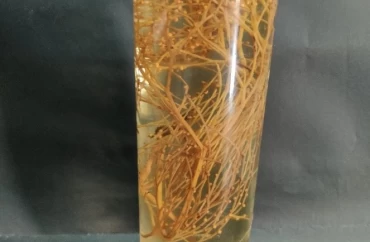
Psilotum
• Psilotum is a genus of fern-like vascular plants. It is one of two genera in the family Psilotaceae commonly known as whisk ferns • They lack true roots and leaves are very reduced, the stems being the organs containing photosynthetic and conducting tissue. • There are only two species in Psilotum and a hybrid between the two. They have stems with many branches and a synangium with three lobes rather than two.
read more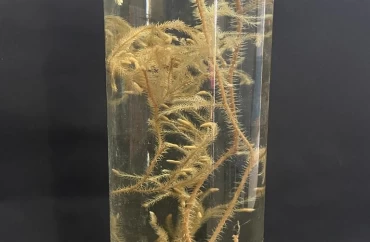
Lycopodium cernum
• Lycopodium, a genus with about 200 species shows a cosmopolitan distribution especially in tropical zone. • The also occur in the colder climates of the arctic regions. The plant of lycopodium, are commonly known as “creeping pine”, “trailing pine” and “club mosses”. • They occur in variable climatic condition, but most of them are moist and shade loving plants
read more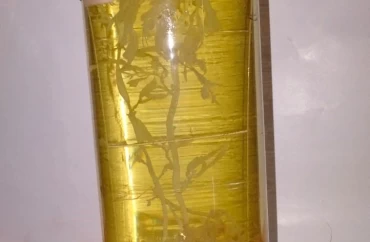
Sargassum
• Sargassum is a type of seaweed, or brown algae, that spends its life on the ocean’s surface and floats in large masses. • Unlike red tide and blue-green algae, sargassum isn’t harmful. • In fact, it’s an important fish habitat that provides food and refuge for fish, birds, crabs, shrimp and many other marine organisms.
read more
Caulerpa
• Caulerpa is a genus of seaweeds in the family Caulerpaceae. • They are unusual because they consist of only one cell with many nuclei, making them among the biggest single cells in the world. • A species in the Mediterranean can have a stolon more than 3 metres long, with up to 200 fronds • Caulerpa is a genus of seaweeds in the family Caulerpaceae (among the green algae). They are unusual because they consist of only one cell with many nuclei, making them among the biggest single cells in the world. • A species in the Mediterranean can have a stolon more than 3 metres (9.8 ft) long, with up to 200 fronds. This species can be invasive from time to time.
read more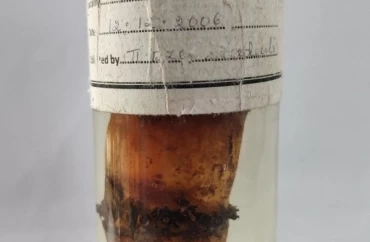
Stilt Roots
Stilt Roots In some plants like maize and sugarcane extra supporting roots arise from the lower nodes of the main stem. These roots grow downwards in a slanting manner and enter the soil. They help to keep the plant upright by providing extra anchorage. These are called stilt roots. They have multiple root caps. Examples are sugarcane, maize and screw pine.
read more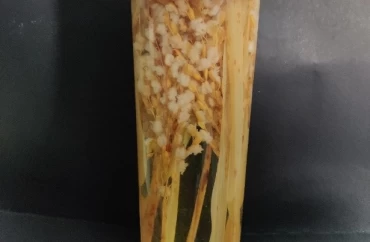
Oryza sativa
Oryza sativa, commonly known as Asian rice, is the plant species most commonly referred to in English as rice. It is the type of farmed rice whose cultivars are most common globally, and was first domesticated in the Yangtze River basin in China 13,500 to 8,200 years ago
read more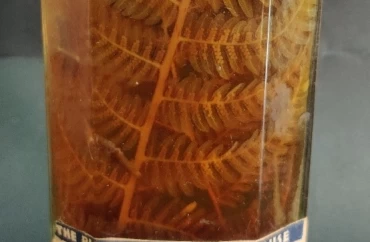
Species of Alsophila
• Species of Alsophila have a treelike growth habit, with an erect trunk that rarely branches, or sometimes a more shrublike habit, with a creeping stem. Their fronds are large, with a strawlike stalk (stipe), dark brown or black in colour. • Brown or dark brown scales are present, with distinct margins. The blade (lamina) of the frond is divided one to three times (one- to three-pinnate). The sori (spore-producing structures) are rounded and borne on smaller veins on the lower surface of the frond. An indusium (a covering to the sori) may or may not be present; if present initially, it may be lost as the frond ages.
read more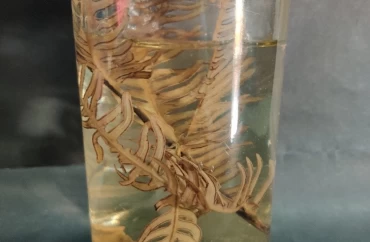
Pteris quadriaurita
• Pteris quadriaurita is a species of evergreen tropical fern. They grow as a rosette of hand-shaped fronds with pinnate leaflets. Spores form in lines under the edge of the leaflets. In the wild they are native to India, where they grow in damp forest shade. • There are a few cultivars with different shades of leaf colour.
read more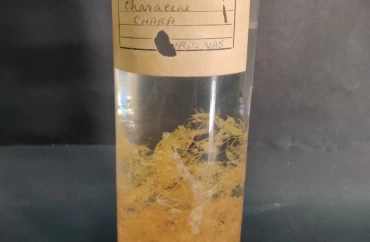
Chara
• Chara is a genus of charophyte green algae in the family Characeae. They are multicellular and superficially resemble land plants because of stem-like and leaf-like structures. • They are found in freshwater, particularly in limestone areas throughout the northern temperate zone, where they grow submerged, attached to the muddy bottom. They prefer less oxygenated and hard water and are not found in waters where mosquito larvae are present. • They are covered with calcium carbonate deposits and are commonly known as stoneworts. Cyanobacteria have been found growing as epiphytes on the surfaces of Chara, where they may be involved in fixing nitrogen, which is important to plant nutrition.
read more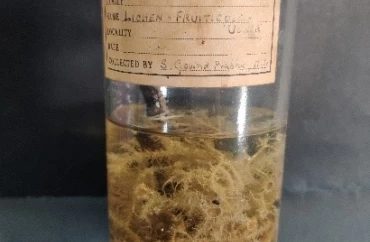
Fruticose lichen
Lichens are found all across North America and all over the world. They are found in a vast diversity of habitats and climates Lichens are a complex life form that is a symbiotic partnership of two separate organisms, a fungus and an alga. The dominant partner is the fungus, which gives the lichen the majority of its characteristics, from its thallus shape to its fruiting bodies. The alga can be either a green alga or a blue-green alga, otherwise known as cyanobacteria. Many lichens will have both types of algae. A fruticose lichen is a form of lichen fungi that is characterized by a coral-like shrubby or bushy growth structure. It is composed of a thallus and a holdfast. It is formed from a symbiotic relationship
read more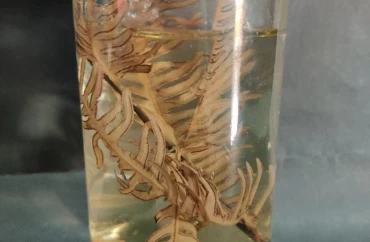
Pteris
• Pteris (brake) is a genus of about 300 species of ferns in the subfamily Pteridoideae of the family Pteridaceae. • They are native to tropical and subtropical regions of the world. • Many of them have linear frond segments, and some have sub-palmate division. Like other members of the Pteridaceae, the frond margin is reflexed over the marginal sori.The outermost layer is the single layered epidermis without stomata.The cortex is differentiated into outer and inner cortical region. The vascular cylinder is an amphiphloic siphonostele. • The term “brake”, used for members of this genus, is a Middle English word for “fern” from southern England. Its derivation is unclear, and is generally thought to be related to “bracken”, whereby the latter word has been assumed to be a plural, as with “children”, and the former word a back-formation. However it may have a separate derivation. • The Latin genus name Pteris refers to the Greek name for fern (also meaning feathery).
read more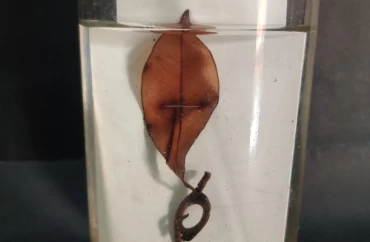
Leaf modifications
Whole leaves or parts of leaves are often modified for special functions, such as for climbing and substrate attachment, storage, protection against predation or climatic conditions, or trapping and digesting insect prey.
read more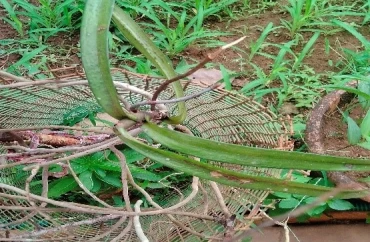
Epiphyte
Acampe produce slow-growing, medium-sized vines that form very large vegetative masses in nature. They are noted for their thick, leathery, distichous leaves. They produce fragrant small to medium-sized yellow flowers, barred with orange or red stripes, in a few to many-flowered racemose inflorescence. The brittle sepals and petals look alike. The ear-shaped, fringed, white labellum (lip) is saccate (sac-shaped) or has a spur, and has red markings at its base. The fleshy column is short and has two waxy pollinia.
read more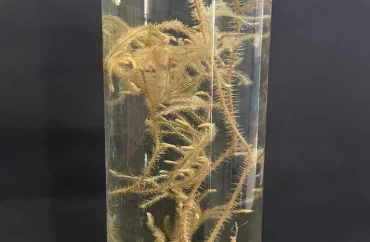
Lycopodium
Lycopodium (from Greek lykos, wolf and podion, diminutive of pous, foot) is a genus of clubmosses, also known as ground pines or creeping cedars, in the family Lycopodiaceae.
read more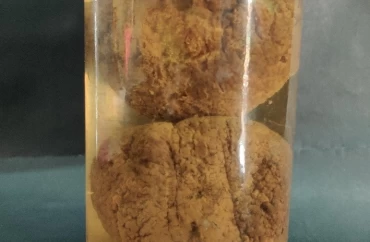
Penicillium on Orange
• Penicillium (/ˌpɛnɪˈsɪliəm/) is a genus of ascomycetous fungi that is part of the mycobiome of many species and is of major importance in the natural environment, in food spoilage, and in food and drug production. • Some members of the genus produce penicillin, a molecule that is used as an antibiotic, which kills or stops the growth of certain kinds of bacteria. Other species are used in cheesemaking. According to the Dictionary of the Fungi (10th edition, 2008), the widespread genus contains over 300 species.
read more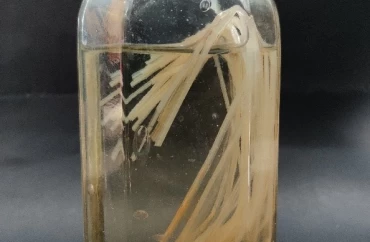
Isoetes
• Isoetes is a genus of plants that almost make up the entire group of plants called quillworts. They are one of the most primitive groups of vascular plants that currently exist on Earth. They form a unique class of lycophytes with roughly 150 species still living today, although many species are now endangered. • The quillworts are spore producing plants that rely heavily on water. Many species live entirely submerged while others live in seasonally flooded habitats. They do not produce flowers, fruits, seeds or wood and have only a single vein that runs through their leaves.
read more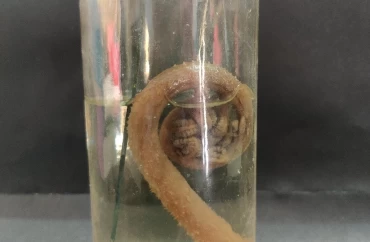
Circinate vernation
Circinate vernation is the type of vernation in which the new leaves emerges in ferns by unrolling from the tight coil. The coiled frond which emerges at first is known as crozier which helps in the protection of tender tips of leaves. The lower parts of frond support the growth and expansion of the frond.
read more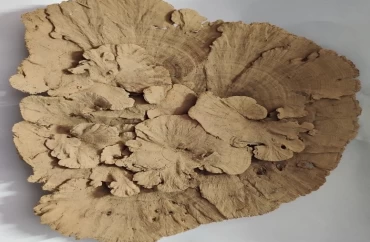
Ganoderma
• Ganoderma is a genus of polypore fungi in the family Ganodermataceae that includes about 80 species, many from tropical regions. • They have a high genetic diversity and are used in traditional Asian medicines. • Ganoderma can be differentiated from other polypores because they have a double-walled basidiospore.
read more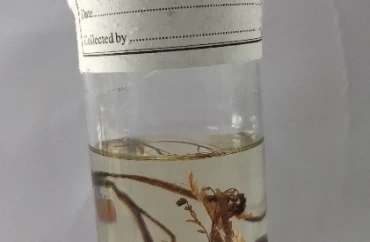
Acacia melanoxylon
• The tree is able to grow to a height of around 20 m and has a bole that is approximately 150 cm in diameter. • It has deeply fissured, dark-grey to black coloured bark that appears quite scaly on older trees. It has angular and ribbed branches The bark on older trunks is dark greyish-black in colour, deeply fissured and somewhat scaly. • Younger branches are glabrous, ribbed and angular to flattened near the greenish coloured tips. • The stems of younger plants are occasionally hairy. Like most species of Acacia it has phyllodes rather than true leaves. • The glabrous, glossy, leathery, dark green to greyish-green phyllodes have a length of 4 to 16 cm and a width of 6 to 30 mm with a variable shape. • They most often have a narrowly elliptic to lanceolate shape and are straight to slightly curved and often taper near the base and have three to five prominent longitudinal veins.
read more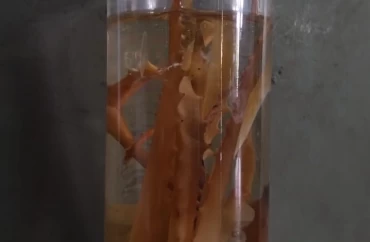
Aloe vera
• Aloe vera is a stemless or very short-stemmed plant growing to 60–100 centimetres spreading by offsets. • The leaves are thick and fleshy, green to grey-green, with some varieties showing white flecks on their upper and lower stem surfaces. • The margin of the leaf is serrated and has small white teeth. The flowers are produced in summer on a spike up to 90 cm tall, each flower being pendulous, with a yellow tubular corolla 2–3 cm long. • Like other Aloe species, Aloe vera forms arbuscular mycorrhiza, a symbiosis that allows the plant better access to mineral nutrients in soil
read more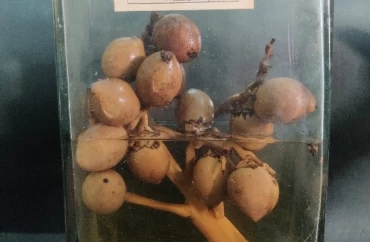
Areca catechu
• The areca nut is important in the Austronesian civilization, especially in the modern day Indonesia and Malaysia. • The seed contains alkaloids such as arecaidine and arecoline, which, when chewed, are intoxicating and slightly addictive. Areca palms are grown in Bangladesh, India, Indonesia, Malaysia, Taiwan and many other Asian countries for their seeds. • The seed also contains condensed tannins (procyanidins) called arecatannins which are carcinogenic.
read more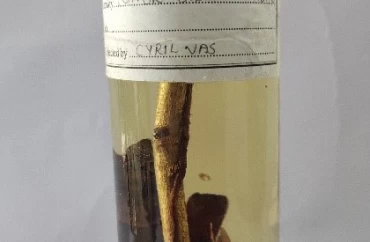
Loranthus
• Loranthus are parasites on cultivated trees for example, they occur in Kerala and Uttarakhand India on mango trees (Mangifera indica), sapota trees (Manilkara zapota) and poplar trees. • The majority of the Anogeissus latifolia trees in the Biligirirangan Hills of Karnataka are infected by Loranthus species and in Africa, they are pests in cocoa plantations. These plants grow strongly on ageing trees particularly somewhere in the middle of old branches. Once established, they steal minerals and water, as well as block sunlight by covering the encroached place. • The flowers of Loranthus are small, green, usually have four to six parts, and may be either unisexual or bisexual. Other species of a broader Loranthus have very large, showy flowers, with blooms in bright colours. The fruits are berries, usually containing a single seed, that is dispersed by birds.
read more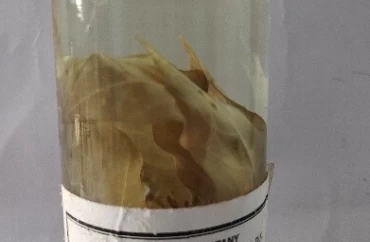
Rauwolfia serpentina
• Rauvolfia serpentina, the Indian snakeroot, devil pepper, or serpentine wood, is a species of flower in the milkweed family Apocynaceae. • It is native to the Indian subcontinent and East Asia (from India to Indonesia). Rauvolfia is a perennial undershrub widely distributed in India in the sub-Himalayan regions up to 1,000 metres (3,300 ft). • It is the source of the phytochemical, reserpine, which has been used in the treatment of systolic hypertension.
read more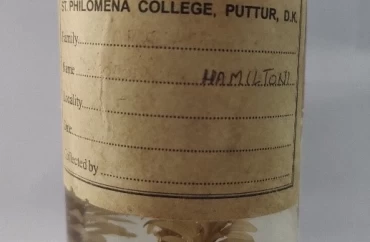
Decalepis hamiltonii
• Decalepis hamiltonii is a species of plant in the family Apocynaceae. It is endemic to Peninsular India and known by its names of nannari beru in Kannada and is a plant whose root is used in Ayurvedic medicines and for use in pickles and to make sharbat. • The English name of swallow root is sometimes used for the plant and studies have shown that it has insecticidal activity and a potential use in control of stored grain pests. The active ingredient in the root was synthesized and encapsulated with beta-cyclodextrins. • The roots were also subjected to supercritical carbon-dioxide based extraction at the Central Food Technological Research Institute, Mysore, India. The plant is often confused with Hemidesmus indicus, Indian The root contains antioxidants and extraction methods for it have been patented
read more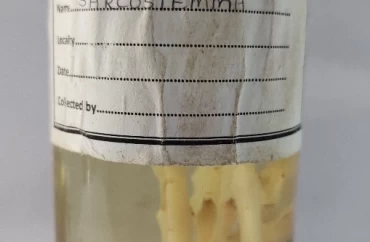
Sarcostemma
• Sarcostemma is a genus of flowering plants in the dogbane family, Apocynaceae, first described as a genus in 1810. • Members of the genus are known generally as climbing milkweeds or caustic bushes.. • These plants are perennial flowering shrubs with trailing vines or lianas. They are often adapted to heat and/or desert conditions. Some have few or no leaves and photosynthesize in the tissues of the green stems. • The soft stems are filled with a milky white latex that is poisonous and caustic in some species. The flowers have a ring of thick tissue at the base which extends into hollow spherical appendages within the flower corolla.
read more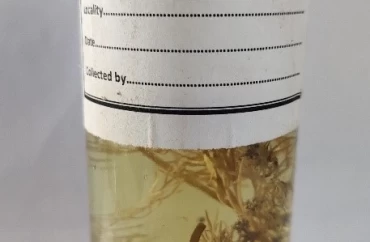
Coriandrum
• Coriandrum is a genus of herbs in the family Apiaceae containing the cultivated species Coriandrum sativum (coriander) and the wild species Coriandrum tordylium. • The leaves and seeds of Coriandrum sativum are used in cooking. The leaves are often referred to as cilantro in North America. • It is also in Tribe Coriandreae.
read more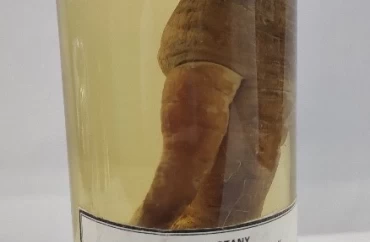
Daucus carota
• The wild carrot is a herbaceous, somewhat variable biennial plant that grows between 30 and 100 cm (1 and 3 ft) tall, and is roughly hairy, with a stiff, solid stem. The leaves are tripinnate, finely divided and lacy, and overall triangular in shape. • The leaves are bristly and alternate in a pinnate pattern that separates into thin segments. The flowers are small and dull white, clustered in flat, dense umbels. The umbels are terminal and approximately 8–10 cm (3–4 in) wide. They may be pink in bud and may have a reddish or purple flower in the centre of the umbel. The lower bracts are three-forked or pinnate, which distinguishes the plant from other white-flowered umbellifers. • As the seeds develop, the umbel curls up at the edges, becomes more congested, and develops a concave surface. The fruits are oval and flattened, with short styles and hooked spines. The fruit is small, dry and bumpy with protective hairs surrounding it. The fruit of Daucus carota has two mericarps, or bicarpellate. The endosperm of the fruit grows before the embryo. The dried umbels detach from the plant, becoming tumbleweeds.
read more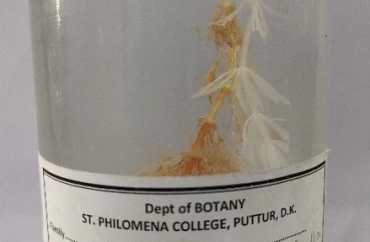
Limnophila (plant)
• Limnophila is a genus of flowering plants in the family Plantaginaceae. It is distributed in tropical and subtropical regions of Africa, Asia, Australia, and the Pacific Islands. Species are known commonly as marshweeds. • These are annual or perennial herbs. They grow in wet habitat, such as marshes, and some are aquatic. Some species are glandular and aromatic. Plants of the genus vary in form, from erect to prostrate, and with branching or unbranched stems. • Submerged leaves are whorled; aerial leaves are whorled or oppositely arranged. The leaves are lance-shaped or pinnate, and the blades have smooth or serrated edges. • The corolla has a lower lip with three lobes and an upper lip that is unlobed or double-lobed.
read more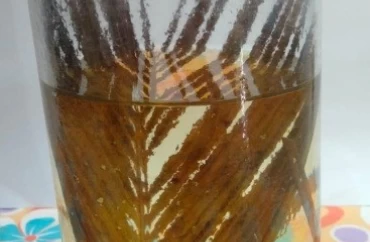
Cycas leaf
There are two types of leaves - foliage leaves and scaly leaves. The foliage leaves are pinnate (or more rarely bipinnate) and arranged spirally, with thick and hard keratinase. They are not permanent and fall off leaving back leaf-bases. The leaflets are articulated, have midrib but lack secondary veins.
read more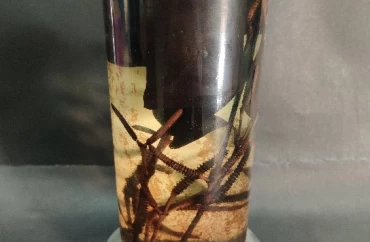
Gnetum
• Gnetum is a genus of gymnosperms, the sole genus in the family Gnetaceae withinthe Gnetophyta. • They are tropical evergreen trees, shrubs and lianas. Unlike other gymnosperms, they possess vessel elements in the xylem.
read more
Puccinia on barberry leaf
Common barberry (Berberis vulgaris) is the alternate host of the wheat stem rust pathogen, Puccinia graminis, under natural conditions in the U.S. Pacific Northwest. Barberry was recently shown to be infected by basidiospores of the wheat stripe rust pathogen, Puccinia striiformis
read more
Leaf rust of coffee
• The symptoms of coffee rust include small, yellowish, oily spots on the upper leaf surface that expand into larger round spots that turn bright orange to red and finally brown with a yellow border. • The rust pustules are powdery and orange-yellow on the underleaf surface. Later the pustules turn black.
read more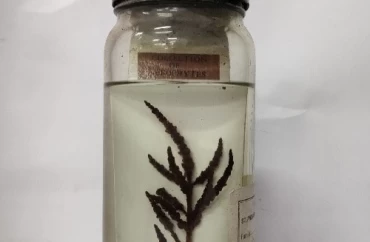
Salicornia
• Salicornia is a genus of succulent, halophytic (salt tolerant) flowering plants in the family Amaranthaceae that grow in salt marshes, on beaches, and among mangroves. • Salicornia species are native to North America, Europe, South Africa, and South Asia. Common names for the genus include glasswort, pickleweed, picklegrass, and marsh samphire.
read more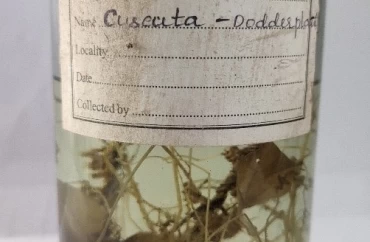
Cuscuta
• Cuscuta, commonly known as dodder, it is a species of yellow, orange, or red parasitic plants. Formerly treated as the only genus in the family Cuscutaceae, it now is accepted as belonging in the morning glory family, Convolvulaceae, on the basis of the work of the Angiosperm Phylogeny • Cuscuta are plant parasites that connect to the vasculature of their host plants to extract water, nutrients, and even macromolecules.
read more
Mustard
• Mustard is a popular condiment made from the seeds of the mustard plant. • This plant is native to the Mediterranean region and related to nutrient-rich vegetables like broccoli, cabbage, and Brussels sprouts. Both its seeds and leaves are edible, making it a versatile addition to your dishes
read more
Equisetum
• Equisetum is a “living fossil”, the only living genus of the entire subclass Equisetidae, which for over 100 million years was much more diverse and dominated the understorey of late Paleozoic forests. • Some equisetids were large trees reaching to 30 m (98 ft) tall. The genus Calamites of the family Calamitaceae, for example, is abundant in coal deposits from the Carboniferous period. • The pattern of spacing of nodes in horsetails, wherein those toward the apex of the shoot are increasingly close together.
read more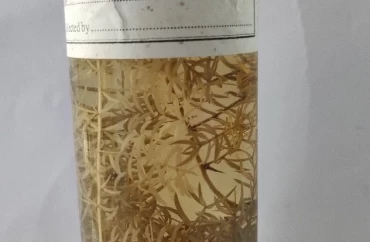
Asparagus
Asparagus is a herbaceous, perennial plant growing to 100–150 cm (40–60 in) tall, with stout stems with much-branched, feathery foliage. The “leaves” are in fact needle-like cladodes in the axils of scale leaves; they are 6–32 mm , long and 1 mm broad, and clustered four to 15 together, in a rose-like shape The root system, often referred to as a “crown,” is adventitious and the root type is fasciculated. The flowers are bell-shaped, greenish-white to yellowish, 4.5–6.5 mm long, with six tepals partially fused together at the base; they are produced singly or in clusters of two or three in the junctions of the branchlets. It is usually dioecious, with male and female flowers on separate plants, but sometimes hermaphrodite flowers are found. The fruit is a small red berry.
read more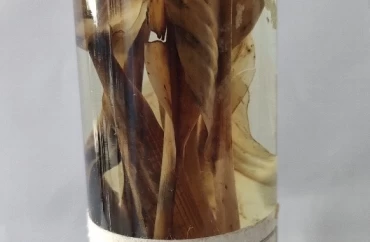
Banana bunchy top disease
• Banana bunchy top is a viral disease caused by a single-stranded DNA virus called the banana bunchy top virus (BBTV). • It was first identified in Fiji in 1879, and has spread around the world since then. • Like many viruses, BBTV was named after the symptoms seen, where the infected plants are stunted and have “bunchy” leaves at the top.
read more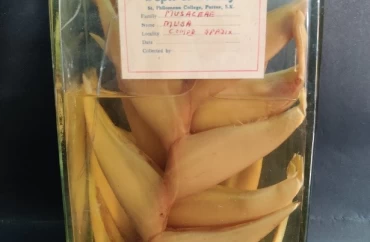
Musa -compound spadix
Spadix inflorescence is found in Musa. Monoecious aroids have unisexual male and female flowers on the same individual and the spadix is usually organized with female flowers towards the bottom and male flowers towards the top.
read more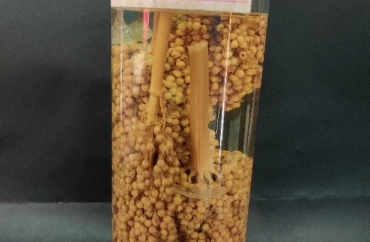
Sorghum
Sorghum is a genus of about 25 species of flowering plants in the grass family (Poaceae). Some of these species are grown as cereals for human consumption and some in pastures for animals. One species, Sorghum bicolor, was originally domesticated in Africa and has since spread throughout the globe.
read more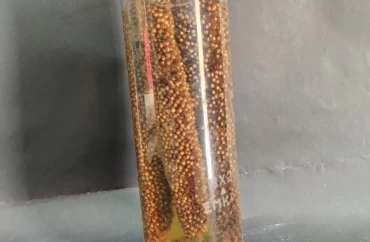
Setaria parviflora
Setaria parviflora is a species of grass known by the common names marsh bristlegrass, knotroot bristle-grass, bristly foxtail and yellow bristlegrass. It is native to North America, including Mexico and the United States from California to the East Coast, Central America and the West Indies, and South America. The inflorescence is a compact, spikelike panicle up to 8 or 10 centimeters long. Surrounding each spikelet are up to 12 yellow or purple bristles. The bristles stay on the stalk after the seeds drop away. This grass grows in moist habitat. It can grow in salty habitat such as salt marshes.
read more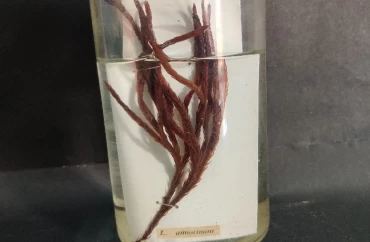
Lycopodium annotinum
Lycopodium annotinum, known as interrupted club-moss, or stiff clubmoss, is a species of clubmoss native to forests of the colder parts of North America It is a common and widespread club-moss spreading by means of horizontal stems running along the surface of the ground. It is usually unbranched or sparingly branched, each branch containing a cone at the top. Leaves have minute teeth on their edges.
read more
Lycopodium phlegmaria
Phlegmariurus phlegmaria, commonly known as either coarse tassel fern or common tassel fern, is an epiphytic species native to rainforests in Madagascar, some islands in the Indian Ocean, Asia, Australasia and many Pacific Islands. Phlegmariurus phlegmaria is commonly found in moist forests and rainforests at high altitudes, in and amongst mosses and other epiphytes. Members of the order Lycopodiales are commonly referred to as clubmosses.
read more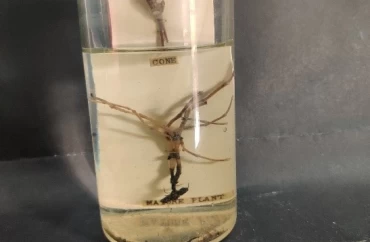
Equisetum
Equisetum is a “living fossil”, the only living genus of the entire subclass Equisetidae, which for over 100 million years was much more diverse and dominated the understorey of late Paleozoic forests. Some were large trees reaching to 30 m (98 ft) tall. The genus Calamites of the family Calamitaceae, for example, is abundant in coal deposits from the Carboniferous period. The pattern of spacing of nodes in horsetails, wherein those toward the apex of the shoot are increasingly close together
read more
Foliaceous stipules
At the base of the petiole, in many plants, a pair of lateral appendages known as stipules are present. Foliaceous stipules (Pisum, Lathyrus)
read more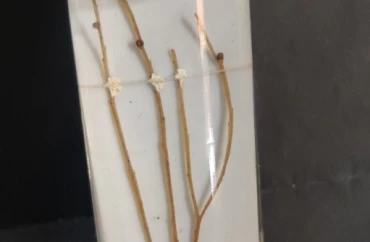
Psilotum
Psilotum is a genus of fern-like vascular plants. It is one of two genera in the family Psilotaceae commonly known as whisk ferns.
read more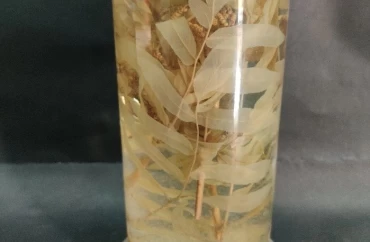
Osmunda
Osmunda-Completely dimorphic fronds or pinnae (hemidimorphic), green photosynthetic sterile fronds, and non-photosynthetic spore-bearing fertile pinnae, with large, naked sporangia. Because of the large mass of sporangia that ripen uniformly at the same time to a showy golden color, the ferns look as if they are in flower, and so this genus is sometimes called the “flowering ferns
read more
Ophioglossum
Ophioglossum, the adder’s-tongue ferns, is a genus of about 50 species of ferns in the family Ophioglossaceae. The name Ophioglossum comes from the Greek meaning “snake-tongue”. Their cosmopolitan distribution is mainly in tropical and subtropical habitats
read more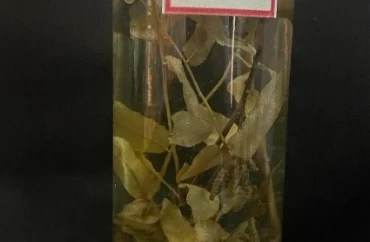
Osmunda
• Completely dimorphic fronds or pinnae (hemidimorphic), green photosynthetic sterile fronds, and non-photosynthetic spore-bearing fertile pinnae, with large, naked sporangia. • Because of the large mass of sporangia that ripen uniformly at the same time to a showy golden color, the ferns look as if they are in flower, and so this genus is sometimes called the “flowering ferns”.
read more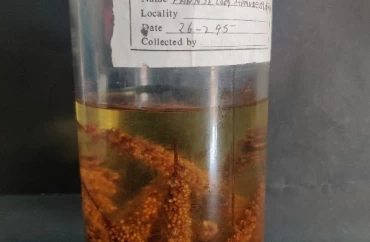
Pennisetum glaucum
Bajra is a traditional Hindi name for the Pennisetum glaucum crop — also known as pearl millet.The grain is primarily grown in Africa and India, where it’s a major source of nutrition. However, it’s also grown and consumed in many other places around the world.Bajra refers to the edible seeds of pearl millet plants. They grow in various shades of white, yellow, gray, brown, and bluish-purple.The seeds are typically cooked as a cereal grain or sometimes finely ground and used as a flour.
read more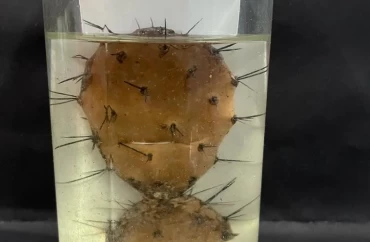
Opuntia Phylloclade
• Phylloclade is the aerial modification of stem, having several nodes and internodes and is modified into a flat, fleshy, and green leaf-like structure and carries out photosynthesis like a leaf and also stores food. • A rhizome is the main stem of the plant that runs underground horizontally. A stolon is similar to a rhizome, but a stolon sprouts from an existing stem, has long internodes, and generates new shoots at the end, such as in the strawberry plant. In general, rhizomes have short internodes, send out roots from the bottom of the nodes, and generate new upward-growing shoots from the top of the nodes. • A stem tuber is a thickened part of a rhizome or stolon that has been enlarged for use as a storage organ. In general, a tuber is high in starch, e.g. the potato, which is a modified stolon. The term “tuber” is often used imprecisely and is sometimes applied to plants with rhizomes.
read more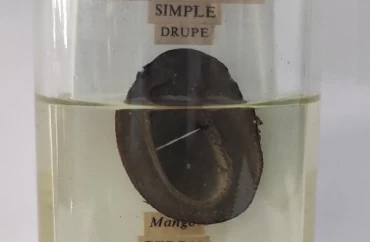
Drupe of Mango
• The definitive characteristic of a drupe is that the hard, lignified stone is derived from the ovary wall of the flower. In an aggregate fruit, which is composed of small, individual drupes (such as a raspberry), each individual is termed a drupelet, and may together form an aggregate fruit. Such fruits are often termed berries, although botanists use a different definition of berry. Other fleshy fruits may have a stony enclosure that comes from the seed coat surrounding the seed, but such fruits are not drupes. • Flowering plants that produce drupes include coffee, jujube, mango, olive, most palms pistachio, white sapote, cashew, and all members of the genus Prunus, including the almond, apricot, cherry, damson, peach, nectarine, and plum
read more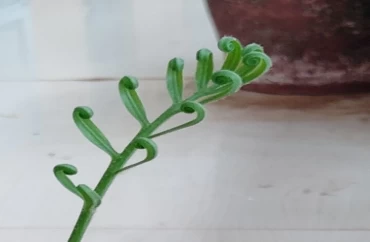
Cercinate vernation in Cycas
Vernation (from vernal meaning spring, since that is when leaves spring forth in temperate regions) is the formation of new leaves or fronds. In plant anatomy, it is the arrangement of leaves in a bud. Cycas vernation is a connecting link between ferns and gymnosperms.
read more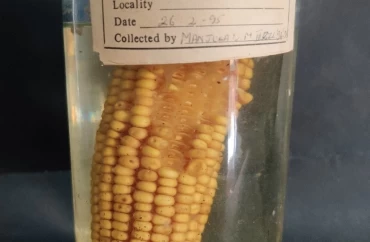
Maize
Maize also known as corn (North American and Australian English), is a cereal grain first domesticated by indigenous peoples in southern Mexico about 10,000 years ago. The leafy stalk of the plant produces pollen inflorescences (or “silk”) and separate ovuliferous inflorescences called ears that when fertilized yield kernelsor seeds, which are fruits. Maize has become a staple food in many parts of the world, with the total production of maize surpassing that of wheat or rice. In addition to being consumed directly by humans (often in the form of masa), maize is also used for corn ethanol, animal feed and other maize products, such as corn starch and corn syrup. The six major types of maize are dent corn, flint corn, pod corn, popcorn, flour corn, and sweet corn. Sugar-rich varieties called sweet corn are usually grown for human consumption as kernels, while field corn varieties are used for animal feed, various corn-based human food and as chemical feedstocks. Maize is also used in making ethanol and other biofuels.
read more
Male cone of Pinus
• Male cone occurs in clusters near the ends of long branches like the short branches are produced in the axils of the scale leaves on long branches. Each male cone is simple ovoid structure about one inch long with 60 to 100 spirally arranged microsporophylls or stamens. They arise from the central axis and pass out horizontally. • Each microsporophyll (stamen) has a short stalk and much longer expanded scale like part on the under surface of horizontal part are borne two microsporangia or pollen sacs. • Inside the sporangia large number of microspore mother cells is present which undergo reduction division and produce haploid microspores or pollen grains.
read more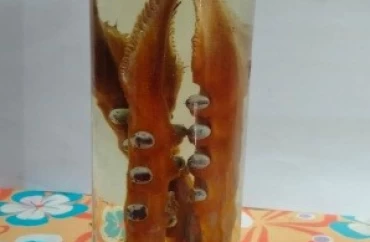
Meagsporphyll of Cycus
• Female cones are developed laterally in the axils of scale leaves. • They are usually produced in clusters in place of shoots of unlimited growth and on different branches from the male cones. • Female cones are much bigger, woody, dry and hard structures. Each female cone has central axis to which are attached megasporophylls. • Each meagsporphyll on its upper surface have two ovules. Each megasporophyll has an outer small bract scale and a large ovulifervous scale. Bract scale arises directly from the bract scale. • The ovule arises as a group of cells which form rounded hump of tissue termed the nucellus (megasporganum). From the base of nucellus an endosing integument grows up which does not enclose nucellus completely but leaves an opening the micropyle which leads to the outer end of nucellus. • Megaspore mother cell undergoes reduction division producing four megaspores arranged in a row each with haploid number of chromosomes.
read more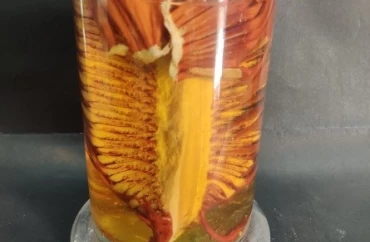
Male Gametophyte of Cycus
Microspore is the unit of male gametophyte. Each microspore or pollen grain is a unicellular body covered with two layered coat. Outer layer the exine is thick and heavily cuticularized while inner layer the intine is very thin. The exine forms two balloon shaped wings on either side. Pinus is wind pollinated and the wings add to the buoyancy of their structures
read more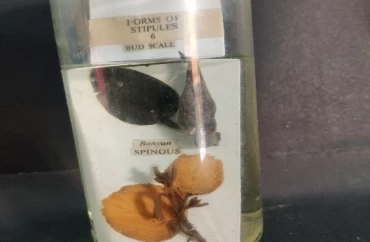
Stipule Modification
Stipule is an appendage present at the base of the leaf stalk. Each leaf of Ficus rubiginosa has a cap-shaped stipule to protect the shoot tip. These are the modified bud scales. These stipules abscise from the stem when the leaf begins to form a petiole and break away from the terminal bud. In Zizyphus, the stipules are spiny. A stipule refers to outgrowths borne on either side of the base of a leafstalk. A pair of stipules is considered part of the anatomy of the leaf of a flowering plant. Stipules appear as scales, hairs, spines or laminar structures. There is a relationship between the stem node and the presence or absence of stipules.
read more
Sandal Spike disease
Spike disease is characterized by extreme reduction in leaf size accompanied by stiffening and reduction of internode length. In advanced stage, the entire shoot gives the appearance of a spike inflorescence. Spiked trees die within 1–2 years after the appearance of visible symptoms. The pathogen, sandal spike phytoplasma, was first detected by electron microscopy in 1969
read more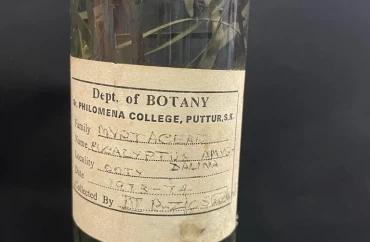
Eucalyptus amygdalina
• Eucalyptus amygdalina, commonly known as black peppermint, is a species of flowering plant that is endemic to Tasmania. • It is a small to medium-sized tree with rough bark on park of the trunk, smooth grey to brown bark above, lance-shaped to linear adult leaves, oval to club-shaped flower buds, white flowers and cup-shaped to hemispherical fruit.
read more

